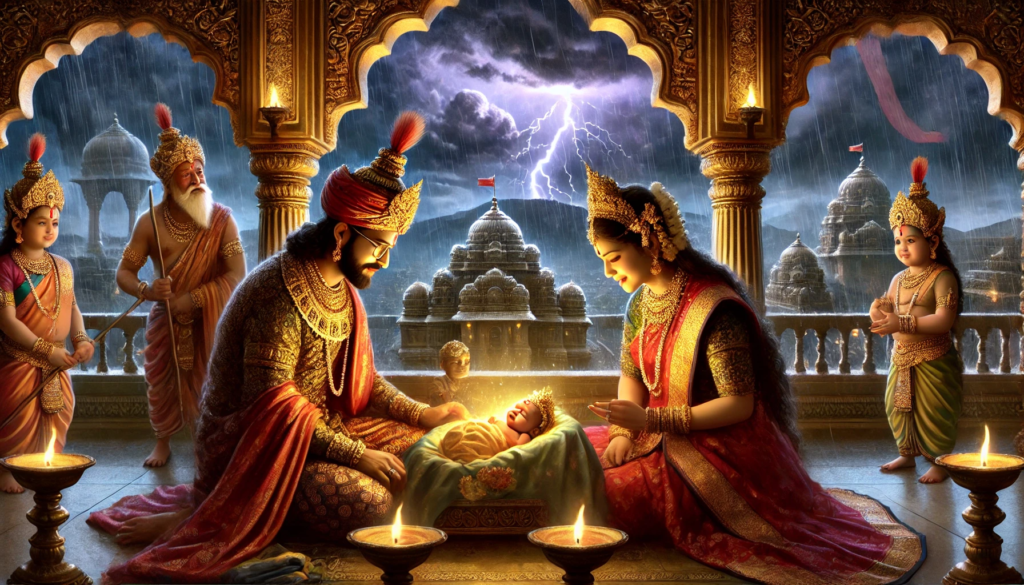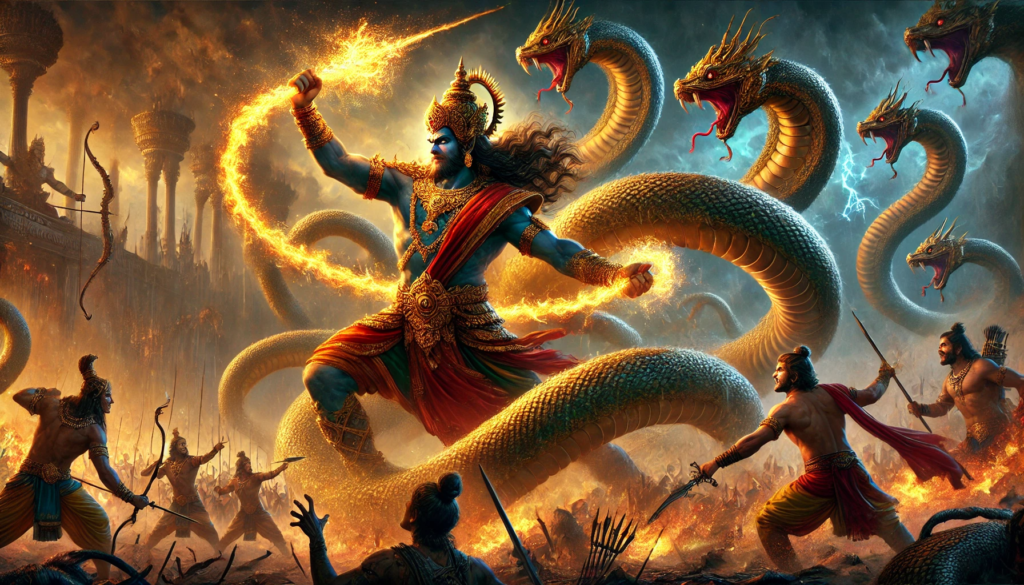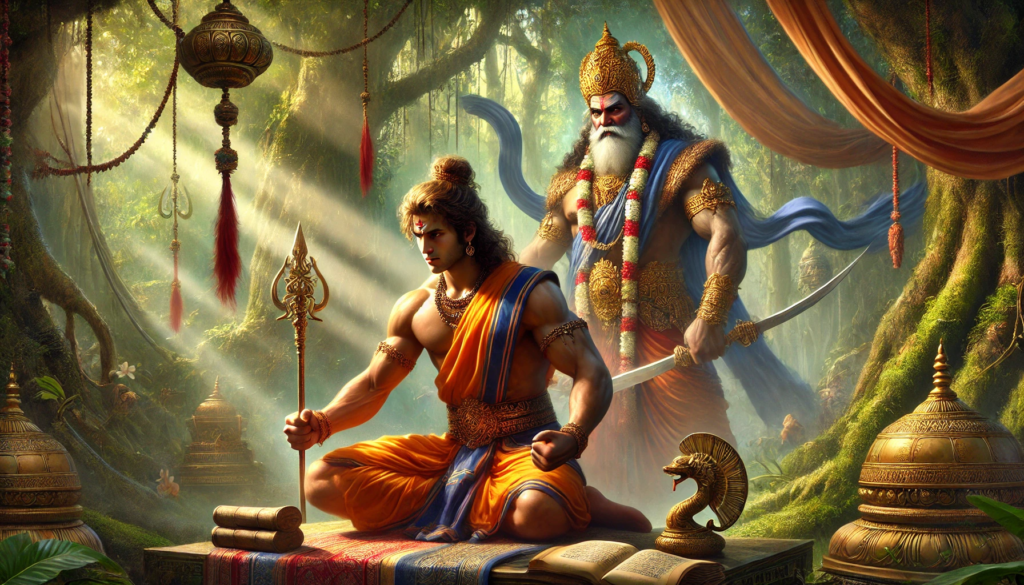Introduction: The Warrior Forgotten by Time
In the grand tapestry of the Ramayana, where gods and demons clash in cosmic battles, one figure stands shrouded in paradox: Indrajit (इंद्रजीत), the crown prince of Lanka. A warrior so formidable that he twice subdued Lord Rama and Lakshmana, humbled Indra in his celestial court, and strategized battles with Machiavellian cunning. Yet, history remembers him only as “Ravana’s son,” his legacy eclipsed by his father’s infamy. Why does a hero who once made devas tremble remain confined to footnotes?
The answer lies in the duality of dharma. Indrajit’s story is not just about martial prowess—it’s a tragic exploration of loyalty, destiny, and the price of inherited sin. Unlike Karna, the Mahabharata’s tragic hero celebrated for his nobility despite his lineage, Indrajit’s narrative is filtered through the lens of Ravana’s tyranny. This article resurrects his saga, weaving Valmiki’s verses, regional retellings, and modern scholarship into a tale that asks: Can greatness be erased by the sins of one’s father?
The Birth of a Storm: Indrajit’s Divine Origins
Ravana’s Heir and the Prophecy of Power

Born as Meghnad (“Thunderous Roar”), Indrajit was no ordinary asura. His birth, as chronicled in the Uttara Kanda of the Valmiki Ramayana, was accompanied by omens: tempests shook Lanka, lightning split the sky, and the seas roared as if heralding a storm incarnate. His mother, Queen Mandodari—often hailed as the “Helen of the East” for her beauty and wisdom—was a direct descendant of the danava architect Maya, granting Indrajit an innate grasp of mystical sciences.
The Shiva Purana (Vidyeshvara Samhita 12.45) adds a divine twist: during her pregnancy, Mandodari dreamt of swallowing the sun, a sign that her son would eclipse even the gods. Ravana, ever the astrologer, cast his son’s horoscope and rejoiced—here was a child destined to conquer Swarga itself.
Key Aspects of Indrajit’s Lineage:
Boons: After a 1,000-year penance, Brahma granted him invincibility in battle—except if attacked during his secret Nikumbala Yagna (a ritual to harness Shiva’s power).
Father’s Legacy: Ravana, the Brahmin-demon king who mastered the Vedas and Shiva Tandava.
Maternal Wisdom: Mandodari’s danava lineage gifted Indrajit mastery over maya (illusion) and tantra.
Celestial Arsenal: The Weapons That Shook the Cosmos
Brahmastra, Nagapasha, and the Art of Invisible Warfare
Indrajit’s education was a fusion of asura might and Brahminical erudition. Trained by Shukra, guru of the demons, and the sage Vishrava (Ravana’s father), he became the Ramayana’s most versatile warrior. His arsenal blended Vedic astras, danava sorcery, and tactical genius:

- Brahmastra – The ultimate nuclear metaphor in Hindu texts. Forged by Brahma’s breath, this missile could “burn the three worlds to ashes” (Valmiki Ramayana 6.59.21). Indrajit’s deployment of it against Rama marked the first time a non-deva wielded it, signaling his defiance of cosmic hierarchy.
- Nagapasha – A serpentine noose gifted by Varuna, god of oceans. When unleashed, it materialized into 10,000 venomous snakes that immobilized victims. Rama and Lakshmana’s survival required Hanuman’s desperate flight to the Himalayas for the Sanjivani herb.
- Tamasi Maya – A cloak of darkness from the Atharva Veda, allowing Indrajit to vanish mid-battle. The Kamba Ramayanam (6.45) poetically describes this as “the sun abandoning its chariot to flee his wrath.”
Scholar Insights:
Dr. Utpal Kumar (Author, Weapons of the Ancients) notes: “Indrajit’s use of Brahmastra wasn’t just warfare—it was a theological rebellion. By wielding a ‘godly’ weapon against gods, he blurred the lines between asura and deva.”
Divine Humiliation: The Day Indrajit Conquered Heaven
The Siege of Amaravati – A Masterclass in Asura Strategy
The Shiva Purana and Padma Purana diverge on why Indrajit invaded Swarga. Some say it was to avenge his cousin’s death; others claim Ravana ordered it to cement Lanka’s supremacy. What’s undisputed is the battle’s audacity.

The Campaign Unfolds:
- Phase 1 – Deception: Indrajit disguised his army as sages and infiltrated Amaravati’s gates.
- Phase 2 – Psychological Warfare: He unleashed the Tvashtra Astra, cloning himself into a thousand duplicates to overwhelm Indra’s forces.
- Phase 3 – Divine Capture: Using the Pashupatastra (a gift from Shiva), he bound Indra in celestial chains and dragged him through Lanka’s streets.
Consequences:
Cosmic Shift: The defeat destabilized the deva-asura balance, forcing Vishnu to incarnate as Rama.
The Lanka War: Indrajit’s Tactical Genius
The Twofold Defeat of Rama – A Feat No Mortal or God Achieved
While Ravana underestimated Rama as a mere mortal, Indrajit recognized the threat. His campaigns in the Yuddha Kanda reveal a Sun Tzu-like grasp of warfare:
Battle 1 – The Invisible Offensive (Yuddha Kanda 47):
- Strategy: Using Tamasi Maya, Indrajit turned Lanka’s battlefield into a pitch-black abyss. His arrows, tipped with serpent venom, struck Rama and Lakshmana from unseen angles.
- Outcome: The brothers collapsed, paralyzed. Only Hanuman’s intervention—a daring aerial quest for the Sanjivani herb—saved them.
Battle 2 – Psychological Destruction (Yuddha Kanda 72):
- The Illusion of Sita’s Death: Indrajit conjured a lifelike Sita doppelgänger and publicly beheaded her. The Vanara army, including Hanuman, fell into despair, believing Rama’s quest futile.
- Rama’s Despair: Valmiki writes that Rama, for the first time, “wept like a common man, his bow slipping from his hands” (6.72.14).
Why These Battles Matter:
Indrajit alone forced Rama—the avatar of Vishnu—to confront mortality. As scholar Arshia Sattar notes: “Rama’s vulnerability in these moments humanizes him, and Indrajit becomes the mirror reflecting his divine struggle.”
Lanka’s Ascendancy: For 14 years, Amaravati’s treasures flowed into Lanka, funding Ravana’s golden age.
The Fall of a Titan: Why Lakshmana Had to Break the Rules
The Nikumbala Yagna – A Ritual Interrupted, A Destiny Fulfilled

Indrajit’s fatal flaw wasn’t weakness—it was overconfidence in his invincibility. The Ramcharitmanas (6.45.3) details his final hours:
- The Secret Ritual: In a hidden grove, Indrajit began the Nikumbala Yagna to invoke Shiva’s boon of immortality.
- Vibhishana’s Betrayal: Ravana’s brother revealed the ritual’s location to Rama, exploiting the loophole in Brahma’s boon.
- Lakshmana’s Sacrifice: Armed with Indra’s Vajra, Lakshmana severed Indrajit’s head mid-chant. The Ramayana’s moral ambiguity peaks here—dharma was upheld through adharma means.
Shloka from Yuddha Kanda (6.89.22):
“Chitrasya nishitair baanair jyotirmayair mahaabalah |
Indrajit shirasya aachchhinat prataapa van hi lakshmanah ||”
“With radiant arrows sharp as fate, mighty Lakshmana,
Severed the head of Indrajit, extinguishing his light.”
Ethical Debate:
Modern Critique: Authors like Devdutt Pattanaik posit that Indrajit’s death symbolizes the cost of blind loyalty: “He chose his father over dharma, and dharma destroyed him.”
Was Lakshmana Justified? Traditionalists argue yes—Indrajit’s allegiance to Ravana’s adharma nullified his right to fair combat.
Why History Silenced Indrajit’s Legacy
The Erasure of an Anti-Hero
Indrajit’s obscurity stems from three cultural biases:
- Narrative Colonization: The Ramayana, preserved by Rama’s devotees, naturally vilified Ravana’s lineage. Regional texts like the Bengali Meghnad Badh Kavya (1889) challenge this, painting Indrajit as a tragic hero.
- The Burden of Bloodline: Ravana’s rape of Sita irreversibly tainted his clan. As Dr. Ananya Vajpeyi writes in Righteous Republic: “In the Indian moral imagination, the sins of the father are the sins of the son.”
- Cosmic Balance: Indrajit’s victories threatened the divine order. His erasure restores Vishnu’s avatar as the ultimate authority.
Contrast with Karna:
Like Karna, Indrajit was noble yet doomed by lineage. But while Karna is celebrated for his charity and loyalty, Indrajit’s loyalty to Ravana reframes him as a “villain.” This duality fuels South Indian and Southeast Asian retellings that sympathize with Lanka’s prince.
Indrajit in Modern Culture: Resurrecting a Legend
From Folklore to Fantasy – The Prince of Lanka Reimagined
Literature: Michael Madhusudan Dutt’s Meghnad Badh Kavya (Bengali, 1861) repositions Indrajit as a Byronic hero, drawing parallels to Milton’s Satan.
Theater: Kerala’s Kathakali dances depict his death with pathos, emphasizing his devotion to Ravana.
Gaming: In Smite, he’s a playable god wielding Nagapasha and Tamasi Maya, introducing Gen Z to his lore.
Rituals: In Tamil Nadu, the Meghnad Samaadhi ritual sees devotees offering lemons and iron weapons to his spirit, seeking courage in adversity.
Share the saga of Indrajit—the warrior who defied heaven but fell to fate. Let his story spark debates on loyalty, legacy, and the lies of history.
Key Citations
- Indrajit – Wikipedia, detailed account of his life and feats
- Here’s The Story Of Indrajit – The Mightiest Warrior In Ramayana And Mahabharata Combined, narrative on his battles
- Valmiki Ramayana – Yuddha Kanda – Sarga 90, primary source for his death
- Indrajit Meghanada – Valmiki Ramayana, details on his training and weapons
- What is the significance of Indrajit in the Ramayana? – PHOOL, analysis of his role
- Ramayana – Laxman vs Indrajit – Ep.245 – Stories From India, account of battles with Lakshmana
- Discover the Legend of Indrajit or Meghnad, Ravana’s Mighty Son | Mythlok, background on his birth
